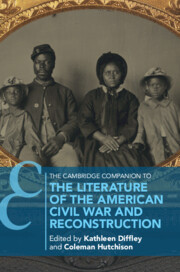Book contents
- The Cambridge Companion to the Literature of the American Civil War and Reconstruction
- The Cambridge Companion to the Literature of the American Civil War and Reconstruction
- Copyright page
- Dedication
- Contents
- Figures
- Contributors
- Acknowledgments
- Chronology
- Introduction
- Part I The Blind Ruck of Event
- 1 Violent Identifications
- 2 Reading, Sociability, and Warfare
- 3 Reconstructing the Civil War Literature of Injury, Illness, and Convalescence
- 4 “The Home and the Camp So Inseparable”
- 5 The Confederacy and Other Southern Fictions
- 6 The Civil War Ballad and Its Reconstruction
- 7 The Unfinished Drama of the American Civil War
- 8 Walt Whitman and the Reconstructive Impulse of Leaves of Grass
- 9 Reconsidering Moses
- 10 From “Facts” to “Pictures”
- Part II Worlds Made and Remade
- Suggestions for Further Reading
- Index
- Cambridge Companions to …
1 - Violent Identifications
Civilian Sectional Rhetorics during the American Civil War
from Part I - The Blind Ruck of Event
Published online by Cambridge University Press: 04 August 2022
- The Cambridge Companion to the Literature of the American Civil War and Reconstruction
- The Cambridge Companion to the Literature of the American Civil War and Reconstruction
- Copyright page
- Dedication
- Contents
- Figures
- Contributors
- Acknowledgments
- Chronology
- Introduction
- Part I The Blind Ruck of Event
- 1 Violent Identifications
- 2 Reading, Sociability, and Warfare
- 3 Reconstructing the Civil War Literature of Injury, Illness, and Convalescence
- 4 “The Home and the Camp So Inseparable”
- 5 The Confederacy and Other Southern Fictions
- 6 The Civil War Ballad and Its Reconstruction
- 7 The Unfinished Drama of the American Civil War
- 8 Walt Whitman and the Reconstructive Impulse of Leaves of Grass
- 9 Reconsidering Moses
- 10 From “Facts” to “Pictures”
- Part II Worlds Made and Remade
- Suggestions for Further Reading
- Index
- Cambridge Companions to …
Summary
The violent disunion rhetorics that swelled in anticipation of Civil War crafted sectional identities for listeners, pitting the interests of opposing sides as irreconcilable. For some, embracing such sectional identities was a rhetorical process. The war-time diary of one Virginia plantation mistress, Ida Powell Dulany, serves as a case study to explore the process of sectional identification and to illustrate the role of proximity to war’s violence in ethos formation. The Dulany plantation, Oakley, sat on a major thoroughfare that both northern and southern troops sought to control, bringing war’s violence to its inhabitants. Oakley represents a site of competing and divergent rhetorical motives and a site of conflict over the meaning of the southern home. The concept of rhetorical becoming accounts for the circumstances, contexts, and locations that shape self-perception and rhetorical action, foregrounding the interplay of public discourses such as disunion rhetorics and individual experiences in shaping a sense of war-time ethos.
Keywords
- Type
- Chapter
- Information
- The Cambridge Companion to the Literature of the American Civil War and Reconstruction , pp. 15 - 28Publisher: Cambridge University PressPrint publication year: 2022

